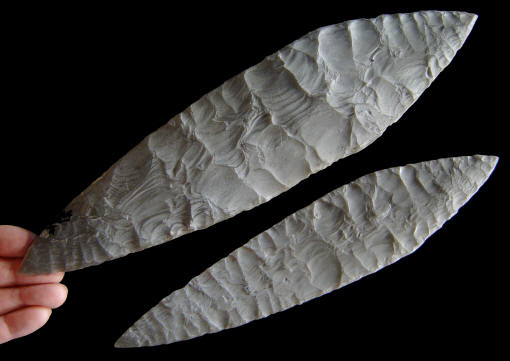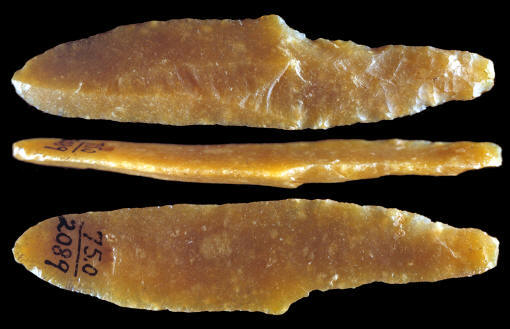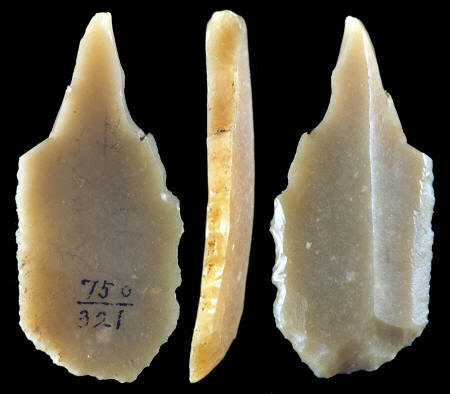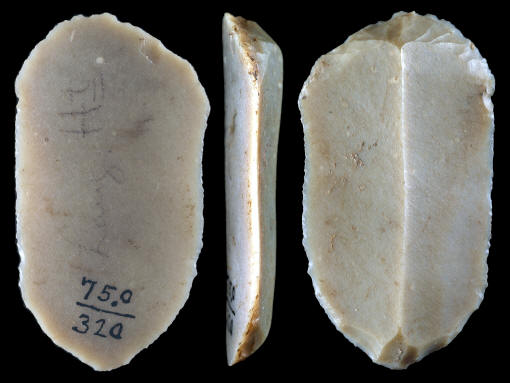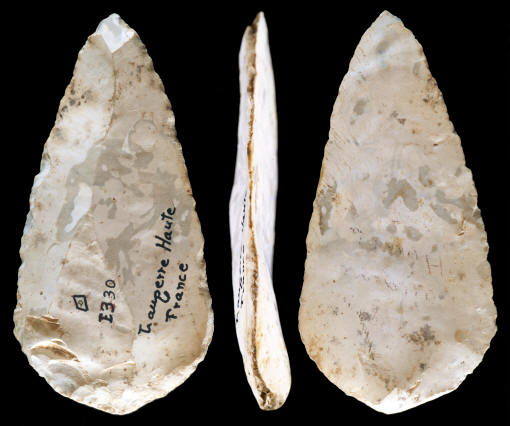|
|
|
Solutrean people were skilled hunters. At Laugerie-Haute 90 percent of the bones in the Solutrean strata were reindeer. They were also hunting horses, wild cattle, ibex and occasionally mammoth and musk-ox. The bones of salmon are also found and at one Solutrean site in Spain the bones from hares indicate they were the principle diet at that location. At the type site of Solutre in east central France the bones of several thousand wild horses were found. These large numbers suggest that the hunters had some form of control over the prey animals, at least in some way that allowed them to harvest wild horses in such large numbers. |
|
|
Four stages of development are recognized within the Solutrean period. An early development stage called Protosolutrean was established for the earliest Solutrean horizon at Laugerie Haute. The Protosolutrean is comprised of many more end scrapers than burins. The characteristic point is a leaf-shaped uniface point with one plain face and the other retouched. There are also Mousterian type tools such as side-scrapers and discs. As the Solutrean industry progresses, the next more developed stage is called the Lower Solutrean. During this time, the leaf-shaped points remain but are more bifacially flaked towards the end of this phase. The Middle Solutrean is characterized by large numbers of leaf-shaped points that are often finely made and are bifacially flaked. They represent the first laurel-leaf points. The Upper Solutrean is the last phase. It developed two new point types which are the shouldered points and willow leaves. Laurel-leaves and uniface points also continue to be produced plus examples of stemmed and barbed points also appear during this time. Additionally, the Upper Solutrean phase in Spain began to make points with concave bases. |
|
|
The Solutrean is most famous for the development of thin bifaces called laurel-leaves. Towards the later Solutrean period, the flint smiths were able to produce some of the most skillfully crafted thin bifaces that has ever been made. They were certainly the finest produced during all of the Upper Paleolithic period. In 1957, the Russian scientist, S. A. Semenov, refers to Solutrean and the process of making a thin biface as "the so-called Solutrean retouch." In this early English translation he explains the process "The peculiarity of this (bifacial reduction) is that it was a method of pressure on the edge of the flint rough-out (preform), used by Upper Paleolithic man, not just to remove tiny flakes and alter the angle of the point and shape of the (core) blade, but also to take off large and relatively thin flakes from the surface of the rough-out (preform). In other words it increased the plastic possibilities of stone working. By this means the irregular rough-out (preform) could be given a desired thickness at any point, made flatter, the end sharpened; the curve taken out of the top, edge or base." |
|
|
Most Flintknappers today use percussion flaking to strike off the largest reduction flakes to form a thin biface. They use either an antler or copper tool to accomplish this task. The rest of the process is done by pressure flaking, again, with either an antler or copper tool. But Francois Bordes mentions indirect percussion concerning Solutrean laurel-leaf points and writes that "The majority of these specimens (Volgu cache) were chipped by direct percussion; but for the finer ones, indirect percussion or pressure has been used." Also, Jacques Bordaz writes concerning the manufacture of laurel-leaf points, "Indirect percussion using a punch applied on the prepared-edge platform is a possibility." Their consideration of the use of indirect percussion is interesting. |
|
|
Besides the development of the first thin bifaces in the form of laurel-leaf points the Solutrean culture also developed other new and innovative ideas. Bordes writes that, "---the Solutreans sometimes treated flint by means of heat, which makes pressure-flaking easier." Also, during the Upper Solutrean phase, the first eyed needles make their appearance. In the area of art, the Solutrean began to produce some of the first deep cave paintings and impressive bas-reliefs. At Roc de Sers, in the Charente region of France, Solutrean artists fashioned large figures of horse, bison, reindeer, mountain goat and one human at the back of the rock shelter, some of them stand out almost 6 inches (15 cm) in relief. There is evidence that the spear thrower is also being used by Solutrean hunters. |
|
|
The Solutrean is remarkable for what they accomplished in such a short period of time in a harsh climate. It's obvious they were able to adapt quite well from pressures of a changing environment. The Volgu cache represents their golden age of the flintknapper's craft. Not many people in all the world have or could presently copy their best work. |
|
|
"REFERENCES"
1921, Macalister, R.
A. S., "A Text-Book Of European Archaeology," Vol. I, p. 371-373. |
|

